Here is my translation of GM Sergey Shipov’s commentary on game 5 of the Anand-Gelfand match. For the original Russian, go to www.crestbook.com. I have added a few remarks to clarify the translation, which are identified [like this. — DM]
Once again, Gelfand equalized with surprising ease as Black, as he has now done in two of the three games he has played with that color.
Tomorrow’s commentary will be posted at Chess in Translation, and I will be back on Sunday. Now, here is Shipov. — DM
Hello, dear friends! Do you hear the murmurs of discontent in our ranks? The public is worried, it demands decisive games in the world championship match. Or at least a bitter struggle to the last drop of blood, to bare kings! And I, grandmaster Sergey Shipov, support this demand. It becomes a somewhat boring spectacle when the adversaries over-insure themselves and do not put forth a one hundred percent effort. Surely you’ll agree that the match is not so long that it would be necessary to save one’s energy so obviously. What kind of “long” match are we talking about? To be frank, it’s quite a short match. A third of the distance has already flashed by, and tomorrow we will complete the first half. And yet no blood has been shed…
So, what might happen today? After a day of rest the contestants are completely capable of starting a battle royale. In the final analysis, they know even better than us that with each new draw the situation becomes more and more slippery. The closer the end of the match, the greater the risk that if you lose a point you won’t be able to win it back. By the way, that brings up one other consequential question — who would be favored in a tie-break?
Yes, I agree that it is still a little bit early, but surely even such a distant prospect has at least crossed the minds of the grandmasters. Everybody knows that Anand is an acknowledged master of rapid chess and blitz. But on the other hand, Gelfand won a number of tiebreaks on his road to the world championship match, and handled himself in exemplary fashion. It seems as if his nervous system is excellently adapted to such overloads of pressure. What kind of nervous system the world champion has now is, however, an open question. It’s all well and good to be a master, but what happens when your palms start sweating and your knees start knocking? All of your former skills can desert you. Which has happened to Vishy more than once…
So, let me bring my perhaps overly emotional introduction to an end. I have only one wish for both of the men fighting for the title:
“Let’s sprinkle the snowballs with red!”
[Shipov is quoting a line from a Soviet-era TV miniseries, called “The Meeting Place Cannot Be Changed,” which became a cult classic. I have not seen the series, and moreover I have read on the Internet that you have to see it to understand what this line means. This is my best shot, and if anyone would like to suggest a better translation in the comments, please do so! — DM.]
(1) Anand,Viswanathan – Gelfand,Boris [B33]
World Championship Match (Game 5), 17.05.2012
[Shipov, Sergey (translated by Dana Mackenzie]
1.e4!
That’s my kind of chess, taking the battle to the front lines. With his very first move Anand demonstrates his aggressive intentions.
1…c5!
Gelfand replies in similar fashion! Instead of insipid play for equality with the Petroff Defense or the Berlin Variation of the Ruy Lopez, he goes into a fighting Sicilian.
2.Nf3 Nc6 3.d4 cxd4 4.Nxd4 Nf6 5.Nc3 e5
The Sveshnikov Variation. [In Russia, it is known as the Chelyabinsk Variation, giving equal credit to both Sveshnikov and Timoshchenko, the Chelyabinsk grandmasters who first gave it credibility. – DM] Ten years ago you would see it in every third game of the elite players. Then the winds changed…
6.Ndb5 d6 7.Bg5
White’s main trump is his control over the d5 square.
7…a6 8.Na3 b5
But Black also has his pluses. The unfortunate position of White’s knight on a3 is one of them.
9.Nd5 Be7 10.Bxf6 Bxf6
White has removed the opposing knight from the board. Now White’s more fortunate knight can make himself comfortable on d5. For a little while.
11.c4
The most popular way to extract the knight from a3. The moral is simple: if Black isn’t afraid of weakening the square d5, why should White worry about weakening the square d4? [Back at the dawn of this variation, in the 1970s, players preferred the more modest 11.c3 ]
11…b4 12.Nc2
[12.Nxb4 with the idea of 12…Nxb4 13.Qa4+ does not pass muster because Black instead plays 12. … Qa5! winning a piece.]
12…0–o
Boris is playing demonstratively quickly — he isn’t even sitting at the board! After making his move he stands up and swalks around… He is exerting psychological pressure on his opponent. But Vishy is a day-old roll. You can’t intimidate him, can’t break through his hard surface. Meanwhile, the pawn on b4 remains under attack, but its taste leaves something to be desired. [The more careful 12…a5 ; or 12…Rb8 are more common.]
13.g3
The champion did at one time experiment with [13.Ncxb4 but without much success: 13…Nxb4 14.Nxb4 Qb6 15.Nd5 Qxb2 16.Bd3 Bd8 17.0–0 Be6 18.Qb3 Qxb3 19.axb3 Rb8 20.Rfb1 Bxd5 21.cxd5 a5 and the position has completely equalized, V. Anand – T. Radjabov, Bilbao 2008. Incidentally, this was the tournament in which Vishy was determined to keep his opening secrets hidden, in advance of his championship match with Kramnik. So no one really took this game very seriously.]
13…a5
It’s necessary to support the pawn after all. Now White has a choice: where to develop his f1 bishop. On g2 or out to h3? [After preparing with h4, of course. – DM] If one could trade off the light-squared bishops without changing the pawn structure, then White would have a solid advantage. But that is not realistic. Black, for example, can place his bishop on e6, offering White the right to trade bishops on that square. Then the f-pawn, arriving on e6, will significantly strengthen Black’s center.
14.Bg2
Anand has decided that the bishop has nothing to do on h3 after all. [14.h4 could be played with other ideas as well. With this move White does not allow Black’s bishop to g5 and possibly prepares a pawn storm. I recall the game A. Morozevich – S. Halkias, Khanty-Mansiysk 2011: 14…a4 15.Qd2 Rb8 16.Nce3 Nd4 17.0–0–0!? Be6 18.Kb1 b3 19.a3 Qd7 20.f4! and Black’s attack has sputtered to a stop, while White’s is just catching fire. The Greek grandmaster was unable to put out the flames.]
14…Bg5
A typical Sveshnikov maneuver. The Black bishop lies in wait for the White knight on e3. Meanwhile it also frees the path for the pawn on f7. It’s true that with the bishop on g2 it is still too early to sharply open up the center. The knight on c6 is awaiting an opportunity to infiltrate on d4. If this doesn’t work out, it can either go to e7 and trade itself for the enemy on d5, or it can make a roundabout maneuver to c5 via b8 and a6. In general, there are many ideas in the position!
15.0–0 Be6
So far the moves of both sides do not raise any questions. Even class-A players could play these moves. The subtle nuances of championship-caliber chess will be revealed a little bit later…
16.Qd3
A solid introduction. White’s first job is to complete his development and only then start his attack. How? The most critical idea here is pressure along the d-file, a pawn break with a2-a3, and possibly an assault with f2-f4. Or in a more unhurried battle White could return to the idea of h2-h4, Kg1–h2 and Bg1–h3. Objectively speaking Black’s house is completely in order, but practice has shown that it is somewhat easier to play White. Proven by Jan Nepomniashchi! [This name is normally transliterated Ian Nepomniachtchi, but that version makes it impossible for English speakers to figure out the correct pronunciation. – DM] But it’s true that to make a proper experiment one should make Jan play ten games or so with Black. Then you would be able to draw a more global conclusion.
16…Bxd5
This move was played so swiftly that there is no doubt — the challenger was not only prepared for this variation but he expected it! He doesn’t even have to stop and remember — all of the moves are in the operating memory of Gelfand’s mental computer. [Here is an example from the main exponent of this variation for White: 16…Ne7 17.Nce3 Bxe3 18.Nxe3 Qc7 19.Rad1 Rfd8 20.b3 Nc6 21.Nc2 a4 22.Rd2 axb3 23.axb3 Qb6 24.h4 Ra2 25.Rb1 h6 26.Kh2 Qc5 27.Bh3 Rda8 28.Kg2 Ne7 29.Bxe6 fxe6 30.Rbd1 Rf8 31.Ne3 Ra6 32.h5 Kh8 33.Ng4 Ng8 34.Qe3 and Black ran into great difficulties in the game Jan Nepomniashchi – A. Timofeev, Irkutsk 2010. The problem is that if the queen retreats from c5, White will execute the break c4-c5.]
17.cxd5
A non-obvious decision. However, if you wish I can explain. [17.exd5 has been played, and led after 17…Nb8 18.h4 Bh6 19.a3 Na6 20.axb4 Nxb4 21.Nxb4 axb4 22.Rxa8 Qxa8 23.c5! to a powerful initiative for White in I. Ilyushenok – D. Dubnov 2008. However, I suspect that after 17. exd5 Gelfand was preparing the elementary 17… Nd4, with the idea of obtaining a position with opposite-color bishops where the number of pawns is an ultra-trivial matter.; 17.Qxd5 is also obviously a fruitless attempt. Black easily establishes a dark-squared dictatorship in the center: 17…Qb6! 18.Rfd1 Rfd8]
17…Nb8
And so the roundabout maneuver that I mentioned earlier has begun. If the runaway horse is able to reach c5, then Black will have an ultra-comfortable game. Every tempo is exceptionally important.
18.a3
A reasonable objection, and a novelty. White attacks the queenside precisely at the moment when Black’s pieces are poorly coordinated. [18.h4 has been seen before, and after 18…Be7?! (18…Bh6! is clearly stronger) 19.a3 bxa3 20.Rxa3 Nd7 21.Rfa1 Nc5 22.Qc4 Rb8 (22…a4 23.b4!) 23.b4 axb4 24.Nxb4 Qb6 25.Nc6 Rb7 26.Qc3 g6 27.Qf3 f5 28.exf5 Rxf5 29.Qe3 Bf8 30.Bh3 Rf6 31.Ra8 White had an advantage, K. Yakubovski – P. Bobras, Czech Republic 2009. Eventually White was able to get to Black’s king.
18…Na6
Boris hastens to complete the maneuver that he has started. He is not frightened by the creation of pawn weaknesses. The opposite-colored bishops will wash Black’s position clean of all its sins… [18…bxa3 was probably also playable. I looked at a variation analogous to the one in the previous game: 19.Rxa3 Na6 20.Rfa1 Nc5 21.Qc4 a4 22.b4 Nb3 23.R1a2 Nc1 24.Rb2 Qc8 and here, with the bishop actively placed on g5, Black need not fear 25.Qc6 because of 25…Ne2+ 26.Kf1 Bc1! However, after 18. … bxa3 it is also worth considering 19. Nxa3!? and the knight can later move to the beautiful and functional square c4.]
19.axb4 Nxb4 20.Nxb4 axb4
The opposite-colored bishops are a sign of an imminent draw in the endgame. But it’s still necessary to survive until the endgame. Black has weak pawns on b4 and d6. However, White has a more vulnerable king position. His rear echelons are more exposed.
21.h4 Bh6
The bishop does not leave its fighting diagonal. Now it prevents White’s rooks from transferring via c1 to c6.
22.Bh3 Amusingly, White’s bishop does the same thing, restricting the movement of his opponent’s heavy pieces. For the first time Gelfand has started thinking seriously, and his time advantage has started to melt away: 1:27 – 1:37. For the moment I don’t see any particular problems for Black if he plays the natural … Qd8-b6. It looks roughly equal. A good plan for Black is to exchange a pair of rooks and play … g7-g6 and … Kg8-g7. Of course it will not be easy to break through with … f7-f5 as long as the enemy bishop is on h3. But in the fullness of time many things can change. [22.Qc4 was another tempting possibility, with the idea of 22…Qb6 (The computer, even though it is a lump of iron, demonstrates the tres chic pawn sacrifice 22…b3!? 23.Qxb3 Bd2! with the idea of transferring the bishop to the a7-g1 diagonal. What can I say, you’ve got to give it some respect.) 23.Qc6! The creation of a passed pawn on c6 is the guiding thread for White’s play.]
22…Qb6
As expected. Black’s long-range artillery is aimed at the square f2.
23.Bd7
It would seem that the bishop is headed for c6, with the goal of wresting control of the a-file. But the idea is not uncontroversial. The bishop for its own sake will be merely a decorative piece on c6. If Black manages to organize some pressure on f2, then …
23…b3
An interesting maneuver. It looks as if the queen is aspiring to b4 … and the rook to a2! And also, in principle, it is useful to fix White’s pawn on b2. In order to gobble it later. [I was thinking about 23…g6 and, for example, in case of 24.Bc6 Rxa1 25.Rxa1 f5 White already has to start thinking about defense.]
24.Bc6
Played quickly. [24.Ra4 is hardly any more promising, because of 24…Rxa4 25.Bxa4 Rb8.
24…Ra2
No sooner said than done. Black does not cede the important file. Of course, one has to ask whether the pawn on a2 might be lost for free.
25.Rxa2 bxa2 26.Qa3
Anand poses the question to his opponent. He attacks both a2 and d6. But the first target is more important, because Black’s passed pawn is too close to its goal. [26.b3 looks too optimistic. To ignore the pawn on a2 so cold-bloodedly is impossible for proteinaceous players like us. However, the computer demonstrates an extraordinary equalizing variation: 26…Rb8 27.Ba4 Rc8 28.Ra1 Rc1+ 29.Rxc1 Bxc1 30.Qc2! Now Black cannot make a second queen because of a back-rank checkmate. But on the other hand, he does have 30…g5! 31.Qxa2 (31.Qxc1 Qd4 32.Qxg5+ Kf8 33.Qd8+ leads to perpetual check) 31…gxh4 32.gxh4 Qd8 33.Qc2 Bf4 and the penetration of Black’s queen on the kingside guarantees him sufficient counterplay.]
26…Rb8 27.Qxa2
and the opponents AGREED TO A DRAW. It’s just the right moment. After Black takes on b2, all the remaining resources for a real battle have completely disappeared.Well, Gelfand confidently won today’s opening duel and easily neutralized Anand’s advantage of the first move. The colossal pre-match work of the challenger’s team is apparent. Good show! And so, the equilibrium in the match is maintained. It’s now time for me, grandmaster Sergey Shipov, to say goodbye. Until tomorrow!
½–½
Download PGN here.
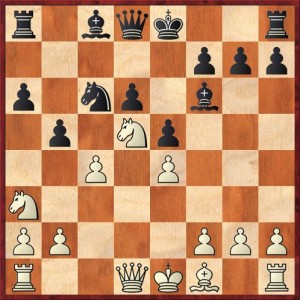
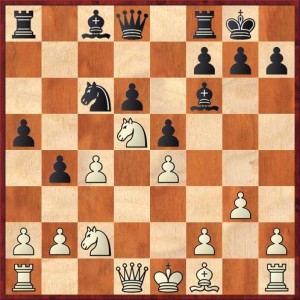
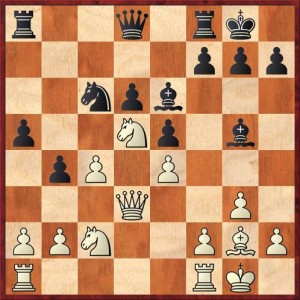
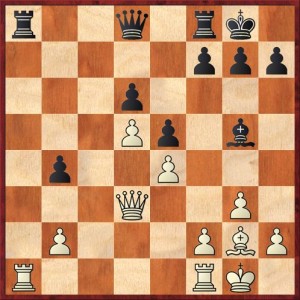
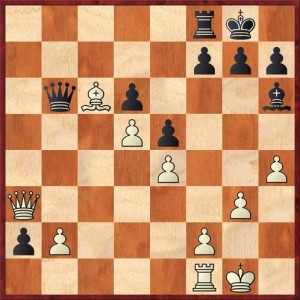



{ 4 comments… read them below or add one }
Fantastic! Thank you!
Hi, Dana! I like you job very much.
As for your translation of the phrase “??????? ?????? ???????????!” it should rather be “Let’s sprincle some snow with red!” And it is actually a kind of invitation for shedding your enemy’s blood on the snow. The word “??????” here cannot be translated as ‘snowbal” since in this context it’s not a ball of snow but a diminutive-hypocoristic (or pet) name for snow.
Good luck!
Thanks, Sirozha. “Sprinkle some snow with red” definitely makes more sense. You’d have to throw a snowball at your opponent pretty hard to draw blood… plus, I imagine that in the movie they were talking about bullets, not snowballs! (Just guessing, of course.)
nice game! lesson of modern chess